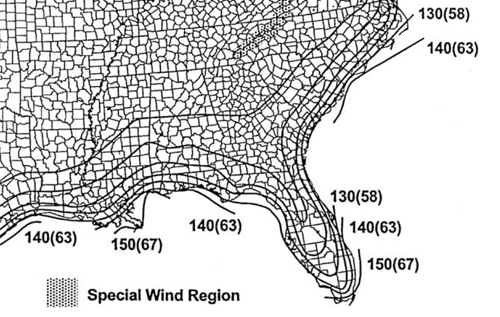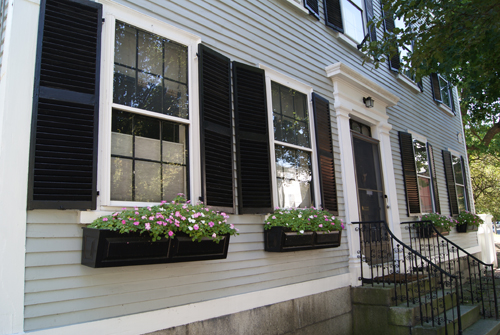The Expense of Logic
I recently did a design for a project in South Carolina, and as is always the case when we do work in areas that are hurricane prone, we researched the need for impact resistant windows. The building code is pretty clear on this, consulting section 1609.1.1 it reads:
Protection of openings. In wind-borne debris
regions, glazing in buildings shall be impact-resistant or
protected with an impact-resistant covering meeting the
requirements of an approved impact-resisting standard or
ASTM E 1996 and ASTM E 1886 referenced therein as follows:
1. Glazed openings located within 30 feet (9144 mm) of
grade shall meet the requirements of the Large Missile
Test of ASTM E 1996.
2. Glazed openings located more than 30 feet (9144
mm) above grade shall meet the provisions of the
Small Missile Test of ASTM E 1996.
Obviously, this statute is intended to protect inhabitant from wind borne debris crashing through the window glass, and rightly so. Hence manufacturers produce various lines of impact resistant windows of layered tempered glass, similar to what you would have in an automobile windshield. Just for your own edification, and for those that may be curious, here’s an example of just such a test the window is subjected to:
Right, so pretty cool, huh? Problem is, impact resistant windows are crazy expensive, especially on high density residential for-rent projects where the cost structure for most properties is pretty thin. But don’t worry, the code provides for an exception to this requirement:
Exceptions:
1. Wood structural panels with a minimum thickness
of 7/16 inch (11.1 mm) and maximum panel span of
8 feet (2438 mm) shall be permitted for opening
protection in one- and two-story buildings. Panels
shall be precut so that they shall be attached to the
framing surrounding the opening containing the
product with the glazed opening. Panels shall be
secured with the attachment hardware provided.
Attachments shall be designed to resist the components
and cladding loads determined in accordance
with the provisions of ASCE 7. Attachment
in accordance with Table 1609.1.2 is permitted for
buildings with a mean roof height of 33 feet (10
058 mm) or less where wind speeds do not exceed
130 mph (57.2 m/s).
Awesome, we can put “panels” over the windows to protect them (when and if the hurricane comes) and we don’t have to pay for the expensive windows. Well, what this means in reality is that the property owner must retain, on site, pre-cut OSB or plywood panels that are ready to then be screwed into the face of the building, over the windows, to protect against the oncoming storm.
The wonders of modern technology. You’d think though that at some point in man’s history, prior to high tech windows, building codes or insurance companies, architects and builders would have been smart enough to come up with a better way to handle this problem. It would be really cool if you just had some sort of built-in solution, something that could become part of the facade, add to its design and character, but also be a functional barrier when hurricane force winds come.
Oh wait…they did…that’s right they are called shutters!
Believe it or not, there was once a time, long, long ago where insurance companies didn’t just reimburse you for damages caused by natural catastrophes, and glass was so expensive that people actually looked for ways to prevent the damage from happening in the first place.
Architecture in the western world has a long and storied tradition with the use of the shutter. Early American architecture particularly, having evolved on the unforgiving East coast, wholeheartedly embraced this prominent element in it’s vernacular vocabulary.
Later, with colonial expansion, designers even developed variants on it like the Bermuda shutter, combining the best parts of an operable shutter to protect the window and a louvered awning to provide shade.
Anyway, back to my project in South Carolina. The client came back this week with some comments on the design (a very traditional one of gabled roofs and brick veneer) asking for shutters on the elevation. Great, two birds one stone right? Nope, this facilitated a discussion of past projects where this has come up, and the consensus has been that it is less expensive, and less of a hassle to screw fake plastic shutters to either side of a window, and pre-cut and store enough OSB on the site to cover them should the next Katrina come. While I don’t doubt this to be true it’s just simply absurd.
Architecture has lost something when this sort of outcome is the norm. People ask me what my favorite “style” of architecture is, and while it’s a cliche, they truly mean it in the Ayn Rand manner of “…everything beautiful in architecture has already been done. There is a treasure mine in every style of the past.” even though I doubt they suspect it. I tell them that I believe in a truthful architecture, one that is honest with itself. Be the design modern or traditional, fake shutters are not an honest piece of fenestration, especially when the employment of the real thing had such clear benefits.
But who cares, if the windows are broken by a storm, the insurance company will just pay for them.
As of today, the shutter issue on my project is still an open ended item. We’ll see how that turns our here in the near future. Until then, I leave you with this excerpt from an online shutter installation how-to-guide. As John Stewart would say, here’s your moment of Zen:








